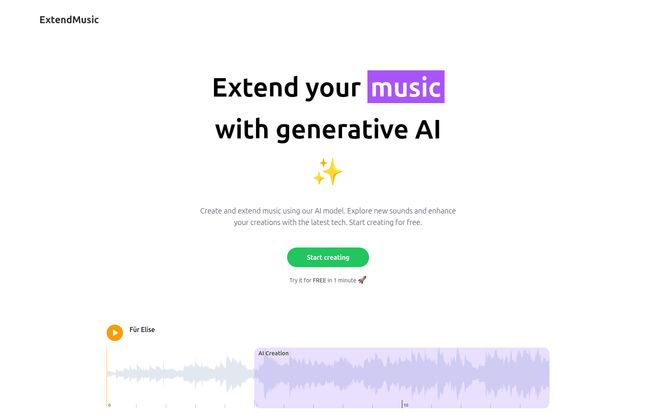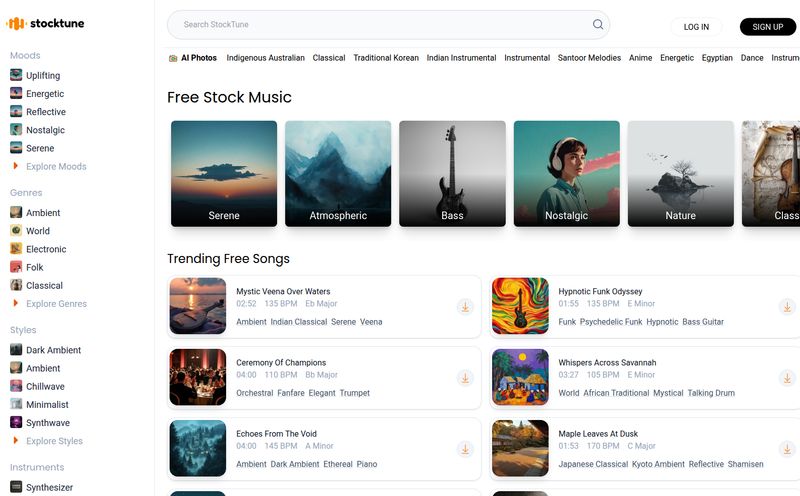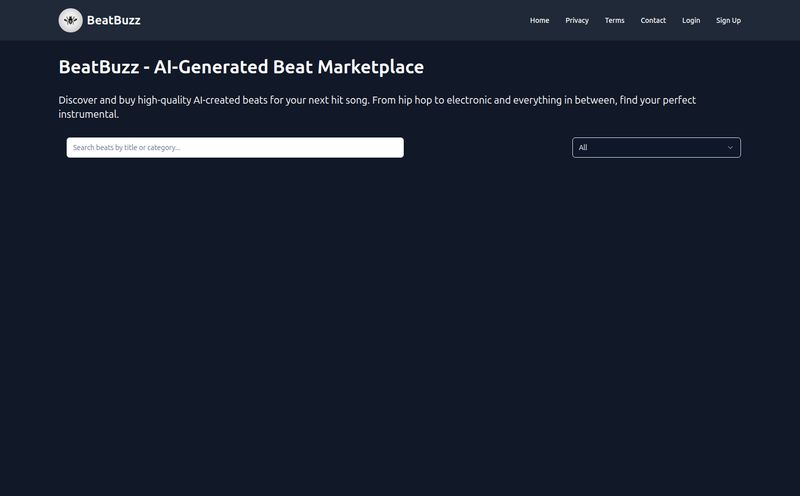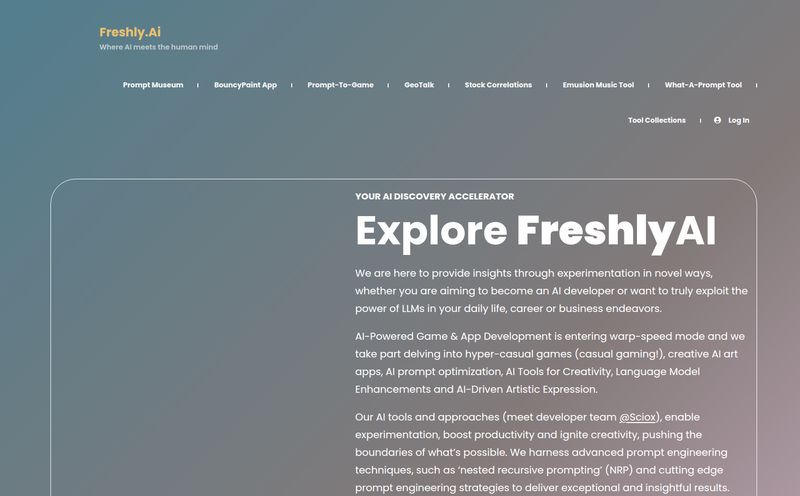If you're a content creator, a video editor, or even just a hobbyist musician, you've been there. You find the perfect piece of background music. It has the right vibe, the right tempo, everything. There's just one tiny, soul-crushing problem: it's 58 seconds long, and your video is five minutes.
So begins the painful ritual. You try to loop it, but the transition is clunky. You slice and dice, trying to Frankenstein a longer version together, but it just sounds... wrong. It’s one of those little frustrations that can derail a whole creative session. For years, this was just part of the job. But we're living in the age of AI, and it seems like a new tool pops up every day to solve these exact kinds of problems. That's what led me to stumble upon ExtendMusic.AI.
The promise is right there in the name. It's an AI tool designed to do one thing: extend your music. But does it work, or is it another clunky AI gimmick? I had to find out.
What Exactly Is ExtendMusic.AI?
At its core, ExtendMusic.AI is a generative AI platform. You feed it a piece of audio, and it composes a continuation of that audio, creating a longer, seamless track. Think of it like a digital session musician who can listen to a few bars of your song and then just... keep playing in the same style. The website says it uses “state-of-the-art AI generative models,” which is pretty standard talk for these tools, but the proof, as they say, is in the pudding. Or in this case, the extended audio file.
The example they use on their homepage is extending Beethoven's "Für Elise." It's a clever choice. It’s a piece everyone knows, so you can immediately hear where the original ends and the AI begins. The idea is to make that transition feel natural, not like a record scratch.
Taking It For a Spin: A Look at The Interface
I’m a big believer that a tool's power is useless if its interface is a nightmare. Thankfully, that's not the case here. The dashboard is clean, simple, and gets straight to the point. No fluff.
Getting Your Music in There
First thing's first, you have to upload your audio. You can pull a file directly from your computer, which is standard. But what really caught my eye was the option to upload from YouTube. This is a fantastic little feature for quickly grabbing a royalty-free track or even a snippet of your own work that you have hosted on the platform. Big plus for that convenience.
Once you've got your file, you give it a name and then you get to the fun part: the controls.

Visit ExtendMusic.AI
The Creative Controls Are the Real Magic
This is where ExtendMusic.AI moves beyond a simple 'make it longer' button. You get a few sliders that give you some serious directorial power over what the AI spits out. It's not just extending; it's guided extending.
- Extend seconds: Pretty straightforward. You use a slider to decide how much extra time you want to add, from 10 to 60 seconds per generation.
- Prompt: This is fascinating. You can give the AI a text prompt, like "add a chill lofi beat" or "more epic strings." This suggests you can actually change the flavor of the music as it extends. I haven't seen this implemented so directly in an extender tool before.
- Creativity: This slider basically tells the AI how closely to stick to the original track. Low values keep it very similar, creating a more consistent loop. High values let the AI get a bit more... well, creative. It might introduce new variations or melodic ideas. This is your 'play it safe' vs 'let's get weird' dial.
- Prompt Influence: This works with the 'Prompt' box. If this is low, the AI might ignore your text prompt. If it's high, it will try its best to follow your text direction. So you can balance how much you want the original audio vs. your new idea to shape the extension.
Playing with these sliders feels less like operating a machine and more like collaborating. You're not just pressing a button; you're giving instructions to a creative co-pilot.
The Good, The Bad, and The AI-Generated
No tool is perfect, right? After playing around with a few tracks, I've got some thoughts. My experience was generally positive, but there are some things to be aware of.
What I Genuinely Liked
The ease of use is at the top of my list. From upload to generation, the process is incredibly intuitive. The control sliders for creativity and prompt influence are also a massive win, giving it a layer of depth that many simpler tools lack. And I'll say it again, that YouTube upload feature is a great quality-of-life touch that shows they understand their user base.
Some Things to Consider
The biggest thing to know is that this is a credit-based system. Every generation costs you something. This isn't necessarily a con—developing and running these AI models isn't free—but it's a factor. We’ll get into teh pricing in a second. Also, the company is a bit tight-lipped about the specific AI model they're using. That’s not a deal-breaker, but for tech-curious folks, it leaves you wondering. Finally, the 'quality' of the output is subjective. Sometimes the AI nails it, and other times it creates something a bit… meandering. It takes a bit of trial and error to get the perfect result.
What's the Cost? A Look at the Credit System
Alright, let's talk about the credits. Based on what I could gather from the interface, the pricing structure is very straightforward:
It costs 1 credit to generate 10 seconds of audio.
So, if you want to add a full minute to your track, you're looking at 6 credits. Simple as that. When I was poking around, I noticed the user account showed I had '8 credits left', so they likely give you a few free credits to start with, which is always a good move.
I did try to find a dedicated pricing page to see what credit packs cost, but the link seems to be down at the moment (I hit a 404 page). This happens, especially with newer platforms. I'm sure they'll get it sorted out, but for now, you'll see the cost per generation right on the 'Generate' button.
So, Who Is This Actually For?
I can see a few groups getting a ton of value out of ExtendMusic.AI:
- YouTubers and Video Creators: This is the most obvious one. Never be a slave to a short background track again.
- Podcast Producers: Need to stretch your intro/outro music or a transitional bed without it sounding repetitive? This is your tool.
- Indie Game Developers: Perfect for creating longer ambient loops for game levels without having to compose hours of music from scratch.
- Musicians with Writer's Block: This is an interesting angle. You could feed the AI a snippet of a song you're stuck on, turn up the 'Creativity' slider, and see what kind of ideas it generates. It could be a great brainstorming partner.
Frequently Asked Questions
Is ExtendMusic.AI free to use?
It operates on a credit system. You'll likely receive some free credits upon signing up to test the service, but for continued use, you'll need to purchase more credits. Each 10-second extension costs 1 credit.
Can I use the extended music commercially?
This is a big question. The website itself doesn't make this immediately clear. As a rule of thumb in the AI world, you should always check the platform's Terms of Service. It also depends on the license of the original music you uploaded. If you upload a copyrighted track, the extension is still a derivative of that copyrighted work.
What audio formats can I upload?
The platform supports direct audio file uploads (likely standard formats like MP3, WAV, etc.) and, most conveniently, can pull audio directly from a YouTube link.
How good is the generated music really?
It varies! The quality is highly dependent on your source audio and the settings you choose. With low 'Creativity,' it can create very convincing and seamless loops. With high 'Creativity,' it can be a source of novel ideas but might also produce something less coherent. It requires a bit of experimentation.
What's the difference between the 'Creativity' and 'Prompt Influence' sliders?
'Creativity' controls how much the AI deviates from the original audio. 'Prompt Influence' controls how much the AI adheres to your text command. You could have low creativity (sticking close to the music's style) but high prompt influence (insisting it adds a 'funky bassline'). They are two separate controls for guiding the AI's output.
Final Thoughts: A Glimpse Into a Longer Future
So, what's the final verdict on ExtendMusic.AI? I'm genuinely impressed. It's a focused tool that solves a common, nagging problem in a very elegant way. It's not here to compose your next symphony from scratch. It’s a collaborator, a tool designed to augment your work, not replace it.
For any creator who has ever been frustrated by the constraints of a fixed-length audio track, this tool is, at the very least, worth a look. The fact that you can control the output with creative sliders and text prompts elevates it from a simple utility to a genuine creative partner. It's a perfect example of AI doing what it does best: handling the tedious stuff so we can focus on the bigger picture.
Reference and Sources
- ExtendMusic.AI Official Website
- MusicTech's Guide to AI Music Generators - For a broader look at the current AI music landscape.



